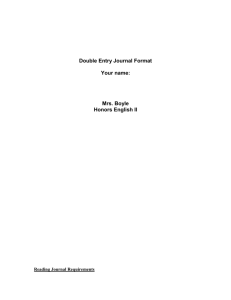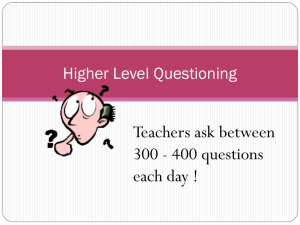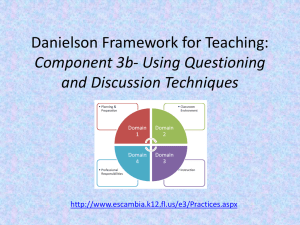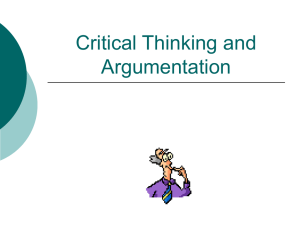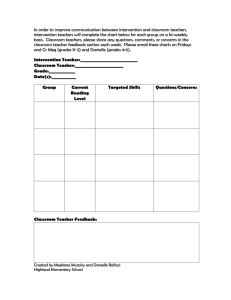Pathwise Instruction Plan
advertisement
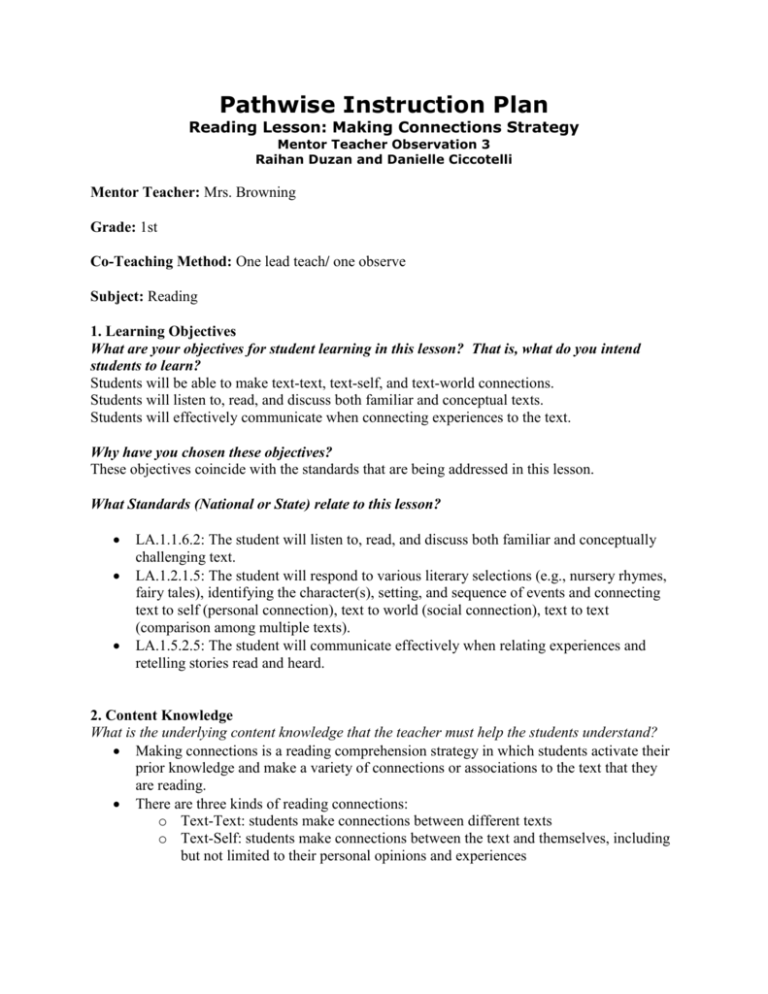
Pathwise Instruction Plan Reading Lesson: Making Connections Strategy Mentor Teacher Observation 3 Raihan Duzan and Danielle Ciccotelli Mentor Teacher: Mrs. Browning Grade: 1st Co-Teaching Method: One lead teach/ one observe Subject: Reading 1. Learning Objectives What are your objectives for student learning in this lesson? That is, what do you intend students to learn? Students will be able to make text-text, text-self, and text-world connections. Students will listen to, read, and discuss both familiar and conceptual texts. Students will effectively communicate when connecting experiences to the text. Why have you chosen these objectives? These objectives coincide with the standards that are being addressed in this lesson. What Standards (National or State) relate to this lesson? LA.1.1.6.2: The student will listen to, read, and discuss both familiar and conceptually challenging text. LA.1.2.1.5: The student will respond to various literary selections (e.g., nursery rhymes, fairy tales), identifying the character(s), setting, and sequence of events and connecting text to self (personal connection), text to world (social connection), text to text (comparison among multiple texts). LA.1.5.2.5: The student will communicate effectively when relating experiences and retelling stories read and heard. 2. Content Knowledge What is the underlying content knowledge that the teacher must help the students understand? Making connections is a reading comprehension strategy in which students activate their prior knowledge and make a variety of connections or associations to the text that they are reading. There are three kinds of reading connections: o Text-Text: students make connections between different texts o Text-Self: students make connections between the text and themselves, including but not limited to their personal opinions and experiences o Text-World: students make connections between the text and the world around them, including but not limited to events in history, current events, the physical world, and individuals in society The effective communication of ideas and experiences involves the use of clear, concise, specific language. What are the tricky pieces in the content? When you deconstruct the content you are teaching what are the pieces that are essential for children to understand? Students will have difficulty with becoming aware that they are making text-text, text-self, and text-world connections. This level of metacognition may be too developmentally advanced for some first grade students. In addition, some students will have difficulty in distinguishing the difference between the three types of connection and classifying their connections into these three categories. 3. Student Grouping How will you group students for instruction? Whole group Individual Why have you chosen this grouping? We chose whole group because this lesson will be an introduction to a comprehension strategy that all students are required to learn. We chose individual grouping to assess students’ understanding and application of the comprehension strategy. 4. Methods What teaching method(s) will you use for this lesson? We will use whole group instruction for the introduction and guided practice of the comprehension strategy. We will then use individual grouping during the assessment segment of the lesson. During this segment, students will be required to apply the comprehension strategy and make connections independently. What students need specific accommodations in this lesson? In our class, we have two ELL students, one “gifted” student, several high-ability students, and three or four students who have difficulties with staying focused when instruction is conducted in whole-group format. What specific accommodations have you made for these student needs? To accommodate our two ELL students and our LD student, we will be using tangible materials that include explicit pictures and easy-to-read words. Furthermore, since we noticed that the ELL students’ and LD student’s oral language is much stronger than their written language, we will begin the lesson by reading the story aloud to our students to ensure that all students understand the story. We will also begin and end the lesson with extensive modeling and discussion. To further our support of our students’ oral language abilities, we will incorporate a cooperative learning activity to give the ELL students meaningful interaction with the content and with their peers. To further support our ELL and LD students’ limited writing ability and our higher students’ strong writing ability, students will be able to choose whether they would like to write or to draw during this activity. This activity is not meant to assess writing ability. As long as students are able to describe their drawings such that their descriptions accurately represent a correctlyclassified connection that they have made to the text, the students are fulfilling the objectives of the lesson. To further assist our LD student in comprehending the material, we will provide him with oneon-one support during the assessment part of the lesson. To accommodate our advanced students, the nature of the “making connections” activity is very open-ended; thus, our advanced students will be able to include additional details in their connections. The advanced students will have the opportunity to interpret the assignment, and they will be encouraged to venture beyond the minimum requirements. Why have you chosen this method or these methods? To accommodate students who are often restless or off-task in whole-group situations, we are incorporating activities that require more interaction between students and teachers or between students and students. 5. Activities What activities have you planned? DAY 1 Opening (5 mins): First Danielle will implement a whole-group introduction to the making connections comprehension strategy. She will ask the students the following question: What do you think it means to make connections? Next, Danielle will guide students towards the understanding that making connections means to relate the text to themselves and their experiences. Then Danielle will discuss the three different kinds of connections, as follows: “Text-Text” means to relate the story to another story that you have read or heard before. “Text-Self” means to relate the story to your personal opinions or experiences. “Text-World” means to relate the story to the world around you, like a place in the world, a person that you know, or an event in history. Activity 1 (20 mins): After this introduction, Danielle will read the book, If You Take a Mouse to School. While reading the book she will stop four times to model the making connections strategy for this particular text. For the first connection, Danielle will use a “teacher think-aloud” to model to students how to make a connection to the text. After she makes her connection, she will ask students the following questions: What kind of connection do you think I made: text-text, text-self, or text-world? (Bloom’s questioning level: comprehension) Why do you think it is that type of connection? (Bloom’s questioning level: application) Based on students’ answers, Danielle will guide students towards the correct answer. Then she will add her connection to the “sticky note” that coincides with the kind of connection that she made. She will either write out her connection or she will draw her connection to illustrate to students that they will be able to choose whether they would like to write or to draw. This modeling process will be repeated two more times. For the fourth and final connection Danielle will ask students to stop and think of a connection that they have made to the text. (Blooms questioning level: analysis) Then, she will ask students turn to their “shoulder partner” to share their connection. Danielle will then use the “name sticks” to choose three students to share their partner’s connection. She will then choose one of these three connections to record as our fourth connection to the text. She will guide students through this process by asking: What kind of connection do you think s/he made: text-text, text-self, or text-world? (Bloom’s questioning level: comprehension) Why do you think it is that type of connection? (Bloom’s questioning level: application) Based on students’ answers, Danielle will guide students towards the correct answer. Then, she will add their connection to a “sticky note” by either writing out their connection or drawing their connection. Closing (5 mins): Danielle will then review the four connections made by herself and by the student. She will also review why each connection is either a text-text, text-self, or text-world connection. DAY 2 Opening (5 mins): First, Raihan will ask the students to join her on the carpet. Then, she will review the types of connections that the students learned about the previous day by asking the following questions: What do you remember about making connections to the books that we read? (Bloom’s questioning level: knowledge, comprehension) What is a connection? (Bloom’s questioning level: knowledge, comprehension) What is a text-text connection? Can you give me an example? (Bloom’s questioning level: knowledge, comprehension, application) What is a text-self connection? Can you give me an example? (Bloom’s questioning level: knowledge, comprehension, application) What is a text-world connection? Can you give me an example? (Bloom’s questioning level: knowledge, comprehension, application) Why are connections important? (Bloom’s questioning level: knowledge, comprehension, application) Based on students’ responses, Raihan will guide students toward the correct responses, as follows: “Text-Text” means to relate the story to another story that you have read or heard before. “Text-Self” means to relate the story to your personal opinions or experiences. “Text-World” means to relate the story to the world around you, like a place in the world, a person that you know, or an event in history. Connections are important because they help us understand what we are reading. Activity 1 (20 mins): Bloom’s task level: application After this introduction, Raihan will explain to students that they will be making their own connections using a decodable book that they have read before (All Kinds of Teams). The students will be expected to follow along as Raihan reads the first two pages. Then, she will guide them through making a connection, classifying the connection, and deciding whether to draw or to write the connection on the paper. Next, she will allow give the students a choice between reading the rest of the book on their own or reading with the teacher. The students who choose to read on their own will sit at the back two tables, and they will be allowed to read using the “reading pipes”, which is a telephone-like device that allows them to listen to themselves whisper-read. These students will be expected to read individually and make as many connections as possible. The students who finish early will be expected to explain their connections with another student who has finished early. (This instruction will be given out as necessary.) The students who choose to read along with Raihan will sit at the front three tables, and they will follow along in the book as Raihan reads. She will stop every three or four pages to give students time to make connections to the book, and she will support the struggling students as necessary. Once the students have made their choices, Raihan will give each student a copy of the book as well as four half-sheets of paper, dismiss the students to their areas, and conduct the activity. Closing (5 mins): Bloom’s task level: synthesis, evaluation Once Raihan has finished reading the book with the teacher-guided group, she will bring all of the students back together for a brief discussion. During the discussion, students will share one connection that they made, classify the connection, and describe how their connection related to the story. 6. Materials What instructional materials will you use, if any? Teacher sticky notes Class set of blank half-pages (at least 3 for each student) Markers Big Book- If you take a Mouse to School Class set – All Kinds of Teams (decodable book) Why have you chosen these materials? The teacher sticky notes, markers, and big book will allow us to demonstrate and guide our students through the strategy. The blank pages and class set of decodable books will allow us to differentiate by giving the students the opportunity to read by themselves or to read with the teacher, as well as the opportunity to write or to draw. Furthermore, the materials serve as handson learning tools that support our students’ preference for tactile activities. 7. Evaluation How and when do you plan to evaluate student learning on the content of this lesson? We will evaluate our students on Day 2 during the individual practice activity. First, while students are working on their connections, we will briefly interview each student at least once regarding the connection(s) that they are making. We will also collect the connections that the students made to the decodable book, and the students will be evaluated based on the following criteria: Level 1: Does not make connections with the text. Level 2: Talks about what text reminds them of, but cannot explain or relate clearly to the text. Level 3: Relates background knowledge/experience to the text. Level 4: Uses background knowledge to enhance comprehension and interpretation. Background knowledge is clearly related to the text. Makes text-to-text, text-to-self, and text-to-world connections. Why have you chosen this approach to evaluation? The Day 2 task will allow us to assess individual students’ understanding of the strategy. By interviewing students and collecting each students’ connections, we are ensuring individual accountability for the content. The rubric that we are using is adapted from a rubric that we are required to use per the requirements of RED4324: Teaching Reading in the Intermediate Grades. The rubric will allow us to place our students’ many connections on a comparable level so that we can determine which students are succeeding and which need additional support.

